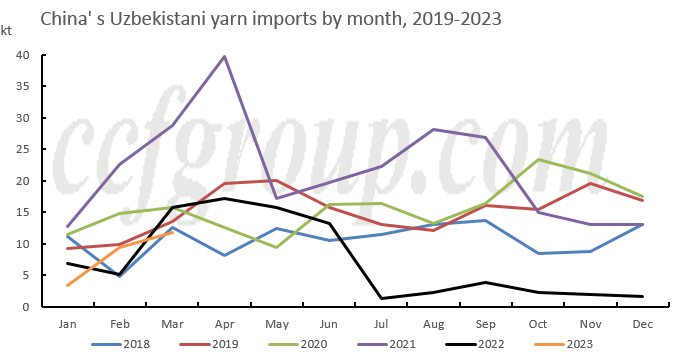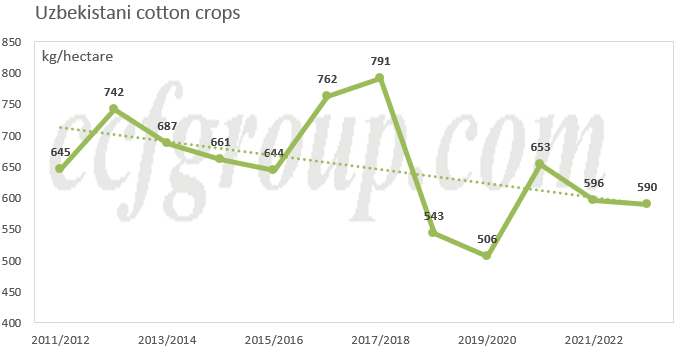Uzbekistan shifts to blended yarn production after cotton shortage
Uzbekistan has always been known for its large cotton crops, which ranks first in Central Asia. But in recent years, with the increasing investment in Uzbekistan's textile industry, the rapid increase in its domestic cotton consumption, cotton shortage has become a problem for Uzbekistan, and the situation didn't get better even after action of stopping cotton exports in 2020. As one of the main sources of China's cotton yarn imports, Uzbekistan's cotton shortage thus are of great concern to Chinese market. At the beginning of this year, due to heavy snow and power outages, many Uzbekistani yarn mills were forced to interrupt production and transportation. After the resumption of production, cotton yarn delivery was repeatedly delayed due to capacity constraints of yarn mills and railroad transportation problems. Recently, the volume of Uzbekistan's yarn exports to Chinese market rebounded slightly compared to the second half of last year, but the expansion of the cotton shortage still caused greater pressure on its local industry chain, and to a certain extent, also weakened the competitiveness of its intermediate and end-product textile exports.

Declining crops due to deteriorating planting conditions
Uzbekistan has relatively favourable conditions for cotton cultivation due to its abundant light and temperature differences, but irrigation has always been a major consumer of water resources and the cost of building an ideal planting area for cotton in the desert is enormous. With the shrinking of the Aral Sea in recent years, the recharge of several large canals in Uzbekistan has been reduced drastically, and the increased salinity of the soil and the shortage of water for irrigation not only affected the incentive of local cotton farmers to grow cotton, but also led to a decline in the crops and quality of cotton. As shown in the chart below, according to USDA data, Uzbekistan's cotton crops in 2022/2023 season declined to about 590 kg per hectare, with total crops assessed at around 650,000mt, and the severe cotton growing situation also required urgently the upgrade of cotton growing technology.

Cotton shortage grows, and many transfer to produce blended yarn
At the same time, the Uzbekistan Commerce Bureau's export report showed that Uzbekistan was still working on reforming its textile industry, trying to develop high value-added end products and transform itself from a major cotton-producing country to a major textile country in order to promote its light industry and local employment. As the graph below shows, the total value of Uzbekistan's textile and clothing exports recently hovered between US$200-300 million, but the value of manufactured goods and garment exports increased from 40% of yarn exports to a dynamic parity between the two, with increasing proportion of yarn flowing into local market.

It is reported that the recent operating rate of most Uzbekistani yarn mills remained at 50% or less, the cotton shortage led to higher cotton prices which spinners cannot afford. Some yarn mills suffered losses since last year and have to suspend production. At present, most of Uzbekistani yarn exports to China were at a marginal profit or barely covered the cost, while exports to Europe, Turkey were slightly more profitable. To relieve the pressure, some mills started to taking on the processing of some garment and home textile end products. On the other hand, they have to shift to blended yarn production in order to reduce cotton consumption and operating costs to maintain normal operating. Recently, increasing number of Uzbekistani manufacturers went to Chinese market for polyester, viscose and modal fibres procurements, mainly from suppliers such as Hengyi Petrochemical, Tangsan Sanyou and Sateri. At present, the production capacity of blended yarns in Uzbekistan has not yet been increased, but the number of blended yarns exported to Chinese market is bound to increase after the production stabilised.
- Top keywords
- Cotton Price
- Cotton Futures Price
- Cotton Futures
- CZCE
- PTA Futures Price
- Chemical Fiber
- Polyester Prices
- Wool price
- PTA Futures
- Shengze Silk
- China
- Yarn Price
- price
- China Textile City
- Fibre Price
- Benzene Price
- Cotton
- Index
- Cotton Index
- PTA
- fabric price
- NYMEX
- Top 10
- textile industry
- Spot Cotton
- Cotton Yarn
- Polyester Price
- Futures
- PTA Price
- cotton yarn price

